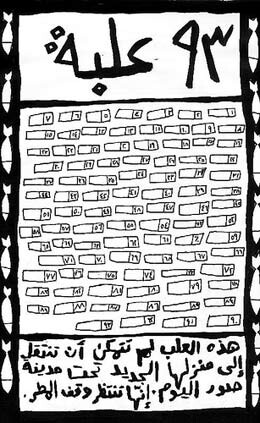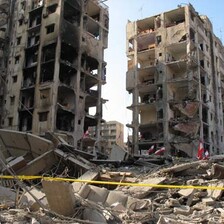Beirut 6 August 2006

“39 Boxes”: These boxes couldn’t move to their new home under the city of Tyr today/They are waiting for the rain to stop by Mazen Kerbaj. View more of his work.
We try to get together every night to talk. It helps relax, or distract us. The out-loud questioning, hypothesizing and arguing makes us feel that there is reason, that we can put the previous day’s violence into a chart and then navigate it to some conclusion, logical or otherwise. We guess which roads we could, if we wanted to, drive on tonight. Which areas of which cities we could visit. But we also know that we will not drive on those roads, and we will not visit friends, family, or even favorite restaurants and bars in different parts of the country. Increasingly, we do not mention, or fantasize about going to the south, where one of us has a family house that we visit at least once each summer.
Still, the talking helps, as do the intoxicants. It makes us feel like we have a modicum of control over our lives. Even if we know it to be a lie, sometimes artifice is productive. And necessary. It helps us get ready for the next day, and the next day’s work.
During the day, we work with the displaced, trying to make their situation a little bit more bearable. Every day, it takes a Herculean effort to cover the needs of just a few hours for just a few of the 900,000 internally displaced Lebanese (and other) citizens.
We also film. Bridges, tunnels, smoke, and stories. I aim my camera, and shoot. Eyes that cry with pain, anger and fear. Hands that wring with worry and knead each other with anxiety. Mouths that speak of loss, of frustration, and of terror.
Sometimes, there is humor and in-the-future invitations to their homes that they were forced to flee from.
“What if your house is no longer there?” I asked one woman who was living, along with 35 other people from five different families in a room that was five by six meters.
“We’ll rebuild it, and then you can come over for a visit”.
When the work is done (and it is never done) the waiting begins. The constant, nagging feeling that this is only the beginning - that things can, and will, get much worse. At the very least, that the invasion will continue and with it, Israel’s indiscriminate aerial, sea and land bombardment throughout Lebanon. No, we are not waiting for a cease-fire. We are waiting for the world to realize the emptiness of these words and learn how the term “cease-fire” is being used to create the time, excuse, and opportunity for more war and death. Ceasefire is following in the path of the word “peace” in the first edition of the dictionary of the New Middle East. Like the operation of the word “peace” in Palestine, cease-fire provides the discursive “cover” under which aggression, occupation, and invasion can continue and metastasize.
The hardest part is the waiting. It fills the body with lethargy.
Inside, we hear the news through the crackles of a transistor radio and the beeping arrival of text messages. Israeli soldiers are trying to “enter” Ba’albeck and Sour. They have been seen in the Beka’a. They are already inside the southern part of the country, and are pushing upwards towards its belly, the Litani River.
In Arabic, the word used is invasion. In English, the word “invasion” is not considered “precise” enough. Perhaps the problem is that it is too precise.
Outside the windows, flying objects are heard cutting through the air. The buzzing sound of reconnaissance, the hovering omnipresence of an F-16. The first night I heard the planes - now more than three weeks ago - I walked quickly into our foyer whenever they broke the sound barrier or fired a missile. I spent the night standing in the corridor between the living room (where the TV was) and the imagined safety of the four-walled foyer where I had spent many nights as a child during a different war. Today when planes approach and missiles are dropped I flinch, but do not move. Fear begins to feel like a luxury, while mourning has become an instinct.
Every day, more corpses are produced while others are found under rubble, in cars, on streets and in shelters. On bridges, in fields, in buses, in bedrooms and in hospitals. Their skin is charred black and ghostly white. The flesh comes away in pieces. Sometimes the pieces need to be gathered and placed together in a plastic bag - a crude simulation of what used to be a whole, living human being. The pieces are then buried in mass graves. Some coffins are less than a foot long. These are for infants.
Yet even this image is deceptive. Coffins, like corpses, come in all sizes. Some coffins do not have names written on their surface because the flesh inside them could not be identified. Some of the smaller coffins contain what is left of a large man. Some of the larger coffins contain the burnt, smothered, or dismembered remains of more than one child - especially if the corpses used to be siblings before they were killed.
At these mass graves, the ground itself mirrors the bodies; it has been turned inside out.
Related Links
Maya Mikdashi is a graduate student at Columbia University. She is co-director of the award-winning documentary film About Baghdad.





